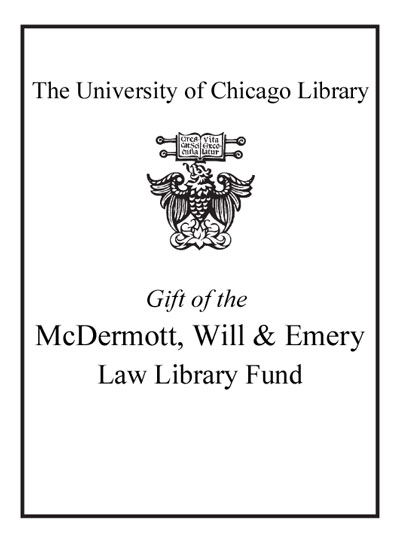EC trade law following China's accession to the WTO /
Saved in:
| Author / Creator: | Hoogmartens, Jan. |
|---|---|
| Imprint: | The Hague : Kluwer Law International ; Frederick, MD : Distributed in North America by Aspen Publishers, c2004. |
| Description: | xxiii, 216 p. ; 25 cm. |
| Language: | English |
| Series: | Global trade and finance series ; v. 6 |
| Subject: | |
| Format: | Print Book |
| URL for this record: | http://pi.lib.uchicago.edu/1001/cat/bib/5576725 |
Table of Contents:
- Overview
- Foreword
- Acknowledgements
- About the Author
- Abbreviations
- Introduction
- 1. Of Bretton Woods, The WTO and The Integration of Transition Economies - Background
- 1.1. Bretton Woods, Free Trade and the World
- 1.1.1. Managing the World Economy
- 1.1.2. Post-Cold War Challenges
- 1.2. Role of the WTO
- 1.2.1. Purposes of WTO Rules and Main Principles
- 1.2.2. Communist Trade Legacy
- 1.2.3. WTO Membership for Transition Economies
- 1.3. Market Economy
- 1.3.1. Different Types of Market Economy
- 1.3.2. Different Types of Therapy
- 1.3.3. Towards Integration in the World Economy
- 1.4. Legal System
- 1.4.1. Capitalism and the Rule of Law
- 1.4.2. Integration into the International Legal System
- 1.4.3. China's Legal Culture
- 1.5. Final Observations
- 2. China's WTO Accession and Domestic Economic and Legal Related Reforms
- 2.1. Socio-political and Historical Background
- 2.1.1. China and the World Community
- 2.1.1.1. Early International Relations
- 2.1.1.2. Present International Relations
- 2.1.1.3. China's Participation in IMF and World Bank
- 2.1.2. China's Road to WTO Accession
- 2.1.2.1. Taiwan's WTO Accession
- 2.1.2.2. Human Rights Concerns
- 2.1.2.3. China's Nonmarket Economy
- 2.2. Domestic Economic Reform
- 2.2.1. State Trading and Article XVII GATT
- 2.2.2. China's Foreign Trade System
- 2.2.3. State-owned Enterprise Reform
- 2.2.3.1. Initial Reform
- 2.2.3.2. Main Approaches
- 2.2.3.3. Management Responsibility System
- 2.2.3.4. Corporatisation
- 2.2.3.5. Social Costs
- 2.2.4. Compliance with Article XVII GATT
- 2.2.4.1. Transparency and State Trading
- 2.2.4.2. Corporate Governance
- 2.3. Domestic Legal Reform
- 2.3.1. Policy versus Law
- 2.3.2. Administrative System
- 2.3.3. Legal Redress and Law Enforcement
- 2.3.3.1. Legal Redress
- 2.3.3.2. Law Enforcement
- 2.4. Final Observations
- 3. EC Trade Policy Response - Safeguards and Market Disruption
- 3.1. Reasons for Concern
- 3.2. WTO Adjustment Mechanisms
- 3.3. Emergency Safeguard Clause
- 3.3.1. WTO Safeguards Agreement
- 3.3.2. EC in the Field of Trade
- 3.3.3. EC Regime on Imports and Safeguards
- 3.3.4. Imports from State-Trading Countries and China
- 3.3.4.1. EC Quotas on Products from China
- 3.3.4.2. EC Emergency Safeguards and Products from China
- 3.3.4.3. Transitional Product-Specific Safeguard Mechanism
- 3.4. Textiles Regime
- 3.4.1. WTO Textiles Regime
- 3.4.2. EC Textiles Regime
- 3.4.3. Quantitative Restrictions on Textiles from China
- 3.4.4. Transitional Textiles Safeguard
- 3.5. Note on Agricultural Products and ECSC Products
- 3.6. Final Observations
- 4. EC Trade Policy Response - Antidumping
- 4.1. The Economic Context of Dumping
- 4.2. The Legal Context of Dumping
- 4.2.1. WTO Antidumping Code
- 4.2.2. EC Antidumping Legislation
- 4.2.2.1. Determination of Dumping
- 4.2.2.2. Determination of Injury
- 4.2.2.3. Determination of Causality
- 4.3. Antidumping and State-Trading Countries
- 4.3.1. Determination of Normal Value
- 4.3.1.1. Selection of the Analogue Country
- 4.3.1.2. Relevant Criteria
- 4.3.1.3. Methods of Determining Normal Value
- 4.3.2. Determination of Antidumping Duties
- 4.3.2.1. Individual Treatment
- 4.3.2.2. Dumping Margin and Adjustments
- 4.4. Final Observations
- 5. Conclusion
- Bibliography
- Index

